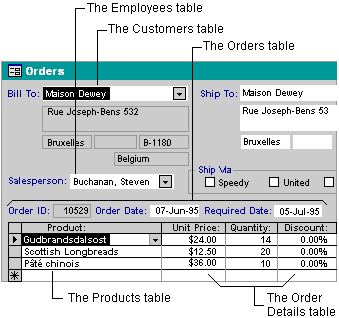
This topic provides reference information about:
Why you should define relationships
After you've set up different tables for each subject in your Microsoft Access database, you need a way of telling Microsoft Access how to bring that information back together again. The first step in this process is to define relationships between your tables. After you've done that, you can create queries, forms, and reports to display information from several tables at once. For example, this form includes information from five tables:

Return to top
In the previous example, the fields in five tables must be coordinated so that they show information about the same order. This coordination is accomplished with relationships between tables. A relationship works by matching data in key fields — usually a field with the same name in both tables. In most cases, these matching fields are the primary key from one table, which provides a unique identifier for each record, and a foreign key in the other table. For example, employees can be associated with orders they're responsible for by creating a relationship between the Employees table and the Orders table using the EmployeeID fields.
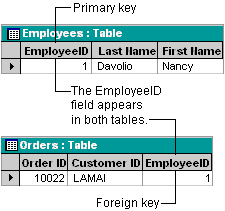
Return to top
A one-to-many relationship is the most common type of relationship. In a one-to-many relationship, a record in Table A can have many matching records in Table B, but a record in Table B has only one matching record in Table A.
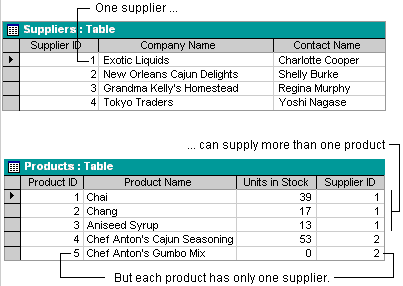
Return to top
In a many-to-many relationship, a record in Table A can have many matching records in Table B, and a record in Table B can have many matching records in Table A. This type of relationship is only possible by defining a third table (called a junction table) whose primary key consists of two fields — the foreign keys from both Tables A and B. A many-to-many relationship is really two one-to-many relationships with a third table. For example, the Orders table and the Products table have a many-to-many relationship that's defined by creating two one-to-many relationships to the Order Details table.
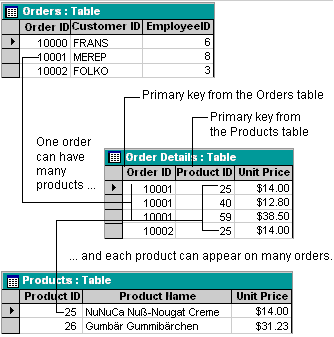
Return to top
In a one-to-one relationship, each record in Table A can have only one matching record in Table B, and each record in Table B can have only one matching record in Table A. This type of relationship is not common, because most information related in this way would be in one table. You might use a one-to-one relationship to divide a table with many fields, to isolate part of a table for security reasons, or to store information that applies only to a subset of the main table. For example, you might want to create a table to track employees participating in a fundraising soccer game.

Return to top
You define a relationship by adding the tables that you want to relate to the Relationships window, and then dragging the key field from one table and dropping it on the key field in the other table. You can also define relationships by using the keyboard.
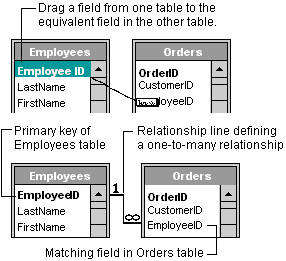
The kind of relationship that Microsoft Access creates depends on how the related fields are defined:
For more information on how to define relationships, click  .
.
Note If you drag a field that isn't a primary key and doesn't have a unique index to another field that isn't a primary key and doesn't have a unique index, an indeterminate relationship is created. In queries containing tables with an indeterminate relationship, Microsoft Access displays a default join line between the tables, but referential integrity won't be enforced, and there's no guarantee that records are unique in either table.
Return to top